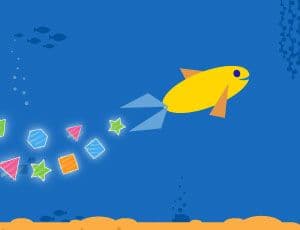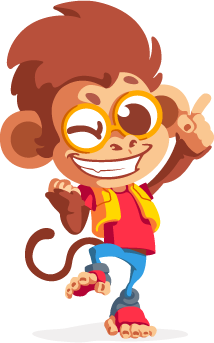Escola Games | Jogos Educativos
https://www.escolagames.com.br
Teacher's support sheet

Geometric Adventure
Do you know circles, triangles, and squares? It’s time to test your geometric knowledge and have fun!
Control the yellow submarine to get as many geometric shapes as you can. Each phase will ask you a different one. Let’s start?

Teacher's tips
Level of Education: Elementary School - Preschool
subject: Mathematics
Theme: Space and shapes
Age: 5 to 7 years old
Geometric shapes are all around us. They are essential in the development of the child's sense of space because it explores the environment they are inserted into even before they start counting. Geometry teaching is associated with the students' daily lives when they have to solve problems and explore and manipulate objects. This game allows students to widen their knowledge and recognize geometric shapes, identifying plane geometric figures and their differences and similarities. [FIM-DICA]
Learner outcomes
To recall geometric shapes;
To relate figures to objects;
To identify and name geometric shapes;
To recognize differences and similarities among the geometric shapes;
To improve the visual discrimination ability; 4
To understand the differences between a square, a rectangle, a triangle, and a circle.
To relate objects to geometric shapes based on their characteristics.
Teachers' goals
To present students with the plane geometric shapes, their characteristics, and names;
To promote the recognition of geometric shapes in their space;
To offer a ludic activity for kids to interact with different geometric shapes so they have significative learning;
To improve their motor skills by using the mouse;
To reinforce content discussed during the classes.
Suggestions of approaches for the teacher
(Approach 1) Take students on a tour around the school. They must observe the environment around them and find geometric shapes. This observation is essential to show students that the content they learn during classes exists outside.
(Approach 2) There is an engaging proposal for a game based on the "Musical Chairs" idea but with geometric shapes. The activity involves taking the students to a suitable space, such as a school gym, and providing them with various large geometric shapes, such as circles, squares, rectangles, triangles, trapezoids, and pentagons, all cut from cardboard sheets. The number of forms should be one less than the number of children in the group. The shapes are placed on the ground, with a small piece of tape to keep them in place if it's too windy. The children walk around the figures as the music plays. When the music stops, each child must stand on one of the shapes. The child who can't find a shape to stand on is eliminated and must remove one form from the playing area, similar to the "Musical Chairs" game. The game ends when only one child is left standing. Throughout the activity, it's necessary to discuss the characteristics of each geometric shape, including its sides, angles, and names, and relate them to everyday objects. This game is a fun way to teach children about geometric shapes while encouraging movement and play.
(Approach 3) Geometric shapes bingo (instead of using numbers).
(Approach 4) Discuss with students the following questions:
● Which is the shape of the black/whiteboard?
● Which is the shape of the notebook?
● Which is the shape of the clock?
● Are all of these objects plane geometric shapes?
● Which are the circle's characteristics?
● Which are the square's characteristics?
● Which are the rectangle's characteristics?
● Which are the triangle's characteristics?
(Approach 5) Inside a box, put different objects, and don't let students see them. Make a hole on the superior side of the box and ask students to put their hands in there and guess which object they got. Then, ask students to describe the shape before taking it out.
(Approach 6) Ask students to draw using only plane geometric shapes.
(Approach 7) Connecting dots - On a side of the notebook, ask the students to draw a circle, a square, a rectangle, and a triangle. On the other side, they have to draw foods with corresponding shapes, for example, ice cream cone = triangle.
(Approach 8) Use popsicle sticks to draw plane geometric shapes.
More about the content
● Define Plane
A plane is a two-dimensional surface measured by two linearly independent points; a plane doesn't have an obvious direction and can extend indefinitely. In algebra, the points are plotted in the coordinate plane which has a number line extending left to right and upwards and downwards endlessly and infinitely. Two planes can be parallel to each other, can be identical, and can intersect each other. A plane has nothing but a surface with no thickness or width. It is always two-dimensional. Imagine a wall and extend it infinitely, it becomes a plane.
● Plane Figures and Shapes
Plane figures include squares, rectangles, triangles, circles, pentagons, octogen, hexagons, ovals, etc. A grouping of shapes is called polygons, like squares and rectangles, but circles and ovals are not polygons. In contrast to solid figures, a closed two-dimensional or flat surface figure is a plane shape. Instead of edges and faces, they possess several light lines that make a corner or a vertex where the two straight lines meet. Some basic plane shapes are triangles, squares, rectangles, circles, and ovals. If we closely observe a sheet of paper, our observation would be on its length and width but no depth, so they are closed shapes as they are made by joining either two straight lines or curved lines. They are also known as plane geometric figures or polygons.
● Examples of Plane Shapes
Plane shapes include squares, rectangles, triangles, circles, pentagons, octagons, hexagons, ovals, etc.
Triangle: A polygon with three sides and three angles is known as a triangle.
Quadrilateral: A closed polygon bounded by four sides is known as a quadrilateral.
Circle: If all points in the figure are equidistant from a fixed point, then it is known as a circle. The fixed point is known as the center of the circle.
Pentagon: If a shape is bounded by 5 sides, then it is known as a pentagon.
Hexagon: If a shape is bounded by 6 sides, then it is known as a hexagon.
https://www.vedantu.com/maths/plane-figures-and-solid-shapes
